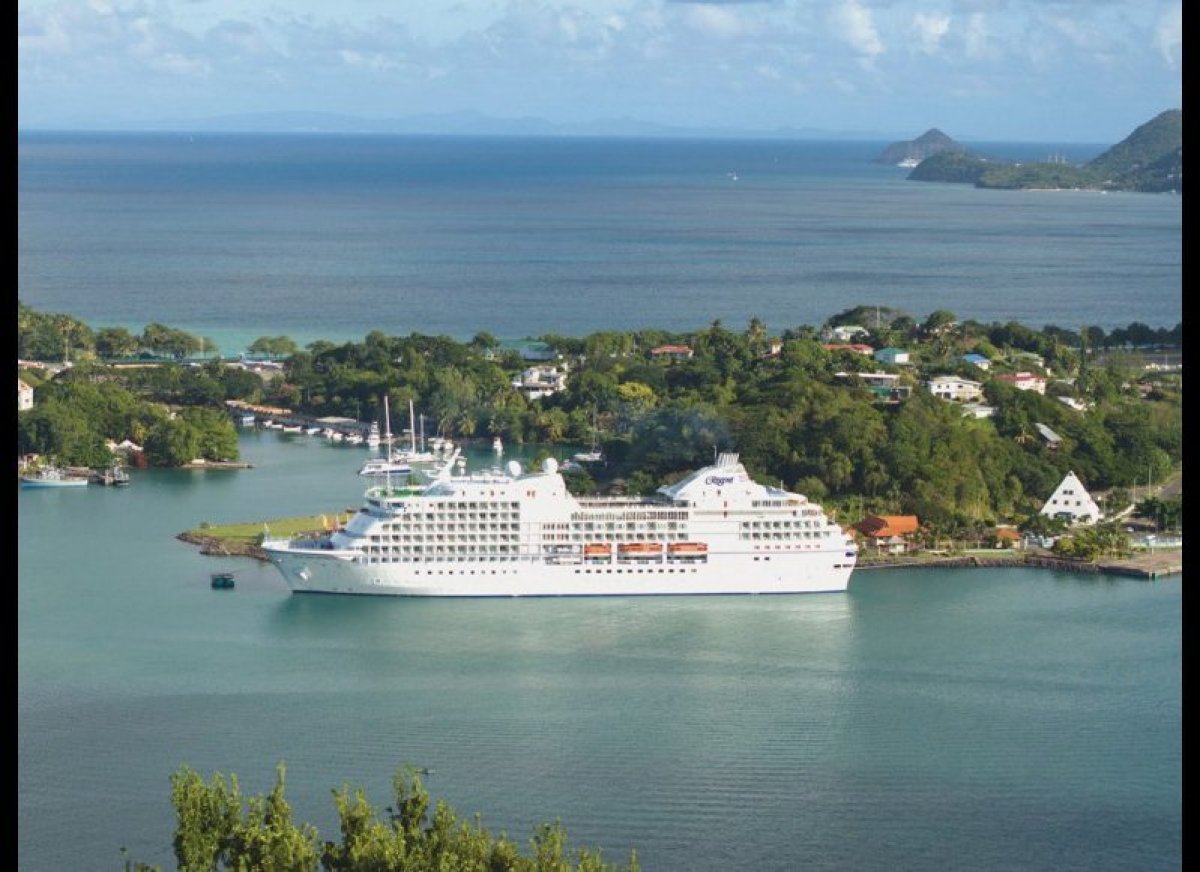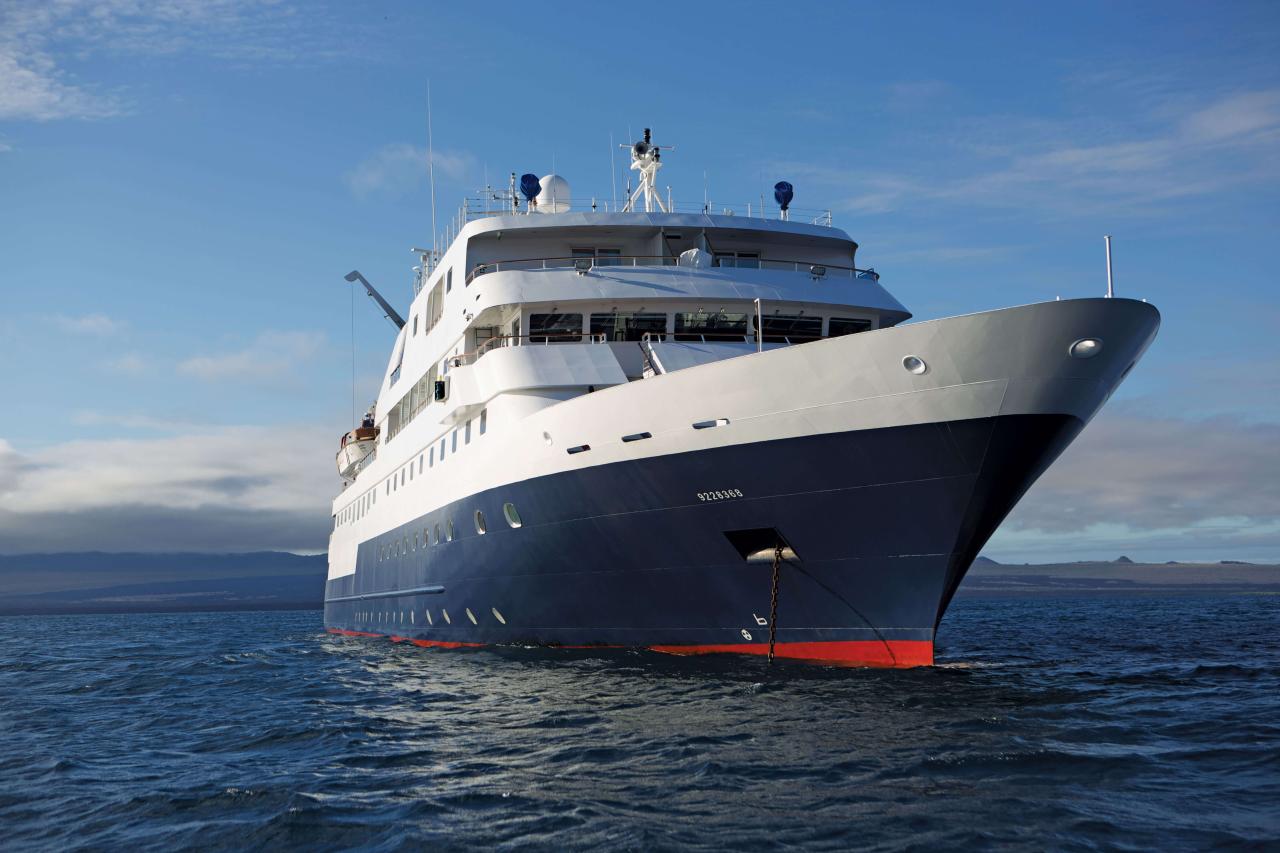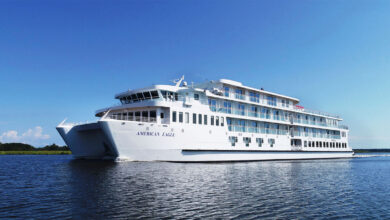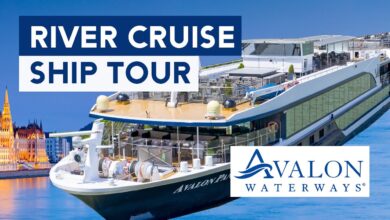
Small Ship Cruises Booming Business
Business is up at small ship cruise companies, and for good reason. These smaller vessels are experiencing a surge in popularity, catering to a specific demographic while offering unique advantages. From personalized experiences to sustainable practices, small ship cruises are tapping into a market craving unique travel opportunities. The reasons behind this growth are multifaceted and will be explored in this article.
This article dives deep into the factors driving this success, analyzing market trends, operational efficiency, customer experiences, and sustainability efforts. We’ll examine the strategies employed by thriving companies, contrasting them with those lagging behind. Get ready to uncover the secrets behind the small ship cruise boom.
Factors Driving Growth

Small ship cruise companies are experiencing a surge in popularity, driven by a confluence of factors. This growth is not simply a fleeting trend but a result of evolving customer preferences, economic shifts, and strategic marketing initiatives. Understanding these elements is crucial for companies looking to capitalize on this expanding market.
Potential Growth Factors
Several factors contribute to the increasing demand for small ship cruises. These range from the inherent appeal of smaller vessels to the evolving needs and desires of modern travelers. Factors include a focus on immersive experiences, enhanced onboard amenities, and a heightened appreciation for personalized service. The appeal of smaller vessels stems from their ability to access destinations that larger cruise ships cannot reach.
This allows for a more intimate and authentic travel experience.
- Focus on Experiential Travel: Small ship cruises often prioritize immersive experiences, offering opportunities for hiking, kayaking, and exploring local culture. This emphasis on authentic interaction with destinations sets them apart from larger, more standardized cruise options.
- Enhanced Onboard Amenities: Many small ship companies are upgrading onboard amenities to provide a higher quality experience. This includes investing in fine dining options, specialized activities, and luxurious accommodations, which contribute to a more premium travel experience.
- Personalized Service: The smaller size of the ships allows for a higher level of personalized service. Cruisers appreciate the opportunity to build relationships with crew and other passengers, fostering a more intimate and connected atmosphere.
- Accessibility to Remote Destinations: Small ships can navigate shallower waters and smaller harbors, enabling access to remote and secluded destinations not reachable by larger vessels.
Impact of Economic Trends
Current economic trends, such as inflation and fluctuating exchange rates, are influencing the small ship cruise market. Budget constraints are prompting travelers to seek more value for their money. The cruise industry is responding by offering competitive pricing and packages, while also emphasizing the unique value proposition of the experience.
Small ship cruise companies are experiencing a surge in business lately, which is fantastic news for travelers. This growth is likely due in part to partnerships like the one between American Queen Voyages and Rocky Mountaineer, allowing for a unique blend of river and train travel experiences. This exciting partnership, detailed in the american queen voyages rocky mountaineer partnership article, is just one example of how innovation is driving this uptick in small ship cruise popularity.
The combination of immersive experiences and smaller group sizes is clearly appealing to a wide range of customers, making it a profitable and exciting sector.
- Inflationary Pressures: Rising prices across the board are impacting travel decisions. Small ship cruises are adapting by offering competitive pricing strategies and value-added packages, which help them remain attractive despite rising costs.
- Currency Fluctuations: Exchange rate fluctuations can impact the affordability of international travel. Companies are working to manage these uncertainties and offer flexible payment options or packages designed for diverse budgets.
- Increased Travel Demand: Despite economic challenges, there’s a renewed emphasis on travel and exploration. This creates a robust demand for unique travel experiences, which is a major factor in the success of small ship cruises.
Role of Marketing Strategies
Effective marketing is critical for attracting and retaining customers in the competitive cruise market. Small ship companies are employing diverse strategies to showcase the unique benefits of their services. This includes digital marketing, targeted advertising, and partnerships with travel agents.
- Targeted Digital Marketing: Small ship companies leverage digital platforms to showcase the unique experiences and destinations they offer. This includes creating engaging content, optimizing for search engines, and running targeted social media campaigns.
- Collaboration with Travel Agents: Partnerships with travel agents are crucial for reaching a wider audience. Agents can provide valuable insights into customer preferences and assist in promoting the cruises.
- Emphasis on Storytelling: Many small ship companies excel at crafting compelling narratives about their destinations and experiences. This focus on storytelling helps to build an emotional connection with potential customers and strengthens brand loyalty.
Comparison of Successful and Less Successful Companies
The success of a small ship cruise company depends significantly on its ability to align its strategies with customer preferences. Successful companies often prioritize customer feedback and adapt their offerings to address evolving needs.
- Adaptability and Customer Feedback: Successful companies actively gather customer feedback and adapt their itineraries, amenities, and marketing strategies based on those insights. This responsiveness fosters customer loyalty and trust.
- Focus on Value: Companies that emphasize the value proposition of their cruises, balancing affordability with quality experiences, tend to achieve greater success. This involves clear communication of the unique benefits and pricing structures.
- Effective Communication Strategies: Effective communication is essential for building trust and anticipation. Successful companies invest in clear and engaging communication across all channels, from website design to social media presence.
Influence of Customer Preferences
Modern travelers seek unique and personalized experiences. Small ship cruise companies are adapting to these changing expectations. This includes focusing on smaller groups, customizable itineraries, and local cultural immersion.
Small ship cruise companies are experiencing a surge in business, likely due to the increased popularity of smaller, more intimate travel experiences. This trend is further supported by the recent opening of a second Waikiki location for Alamo, a popular car rental company, which demonstrates a growing demand for travel services in the area. alamo opens second Waikiki location This, in turn, suggests a positive economic climate that is encouraging more travelers to explore, and this ultimately bodes well for the continued success of small ship cruises.
- Desire for Personalized Experiences: Customers are seeking more personalized travel experiences. Small ship cruises offer opportunities for customized itineraries, specialized excursions, and direct interaction with local communities.
- Emphasis on Sustainability: Growing numbers of travelers prioritize sustainable travel practices. Companies are responding by highlighting eco-friendly initiatives and supporting local communities.
- Preference for Smaller Group Sizes: Many travelers prefer smaller group sizes to foster more intimate and personal interactions with the destinations and other travelers.
Impact of New Technologies and Innovations
New technologies and innovations are transforming the cruise industry. Companies are adopting new booking systems, personalized onboard experiences, and virtual reality tours.
Small ship cruise companies are experiencing a surge in business lately, likely fueled by the popularity of unique itineraries and personalized experiences. The recent refurbishment of the Allure of the Seas, allure of the seas refurbishment , is also probably contributing to the demand for smaller vessels, as travellers look for a more intimate and less crowded cruise experience.
This increased demand for smaller ships is likely to continue, making it a bright spot for the cruise industry.
- Improved Booking Systems: Modern booking systems offer greater flexibility and personalization for travelers. This includes options for customized itineraries and seamless online booking experiences.
- Enhanced Onboard Experiences: Technological advancements are enhancing onboard experiences, from personalized entertainment options to virtual reality tours of destinations.
- Data-Driven Decision Making: Data analytics play a vital role in understanding customer preferences and tailoring services accordingly. This allows for more efficient marketing and improved onboard experiences.
Summary Table
| Factor | Impact | Example of Positive Growth | Description |
|---|---|---|---|
| Experiential Travel | Increased demand for immersive experiences | G Adventures | Offers small group adventures focusing on cultural immersion and hands-on experiences. |
| Enhanced Amenities | Higher perceived value and customer satisfaction | Oceania Cruises | Focuses on luxury amenities and personalized service. |
| Personalized Service | Increased customer loyalty and positive reviews | Viking River Cruises | Offers customized itineraries and highly personalized service. |
| Economic Trends | Impact on pricing and demand | MSC Cruises | Adapts pricing strategies and offers various packages to accommodate economic fluctuations. |
Market Analysis
Small ship cruises offer a unique travel experience, appealing to a specific demographic and catering to a niche market segment. Understanding the target audience, competitive landscape, and emerging trends is crucial for success in this sector. This analysis will delve into the key aspects driving growth and potential challenges within the small ship cruise industry.The market for small ship cruises is characterized by a discerning clientele seeking an intimate and personalized experience.
This contrasts with the mass-market appeal of larger cruise liners, often perceived as impersonal. This distinct characteristic is a crucial differentiator for companies specializing in this niche.
Target Demographics and Preferences
Small ship cruise passengers are typically affluent travelers, valuing personalized service, unique destinations, and immersive cultural experiences. They often prioritize smaller group sizes, allowing for greater interaction with fellow passengers and crew, and a deeper connection with the destinations visited. This segment often includes couples, families, and retirees who seek a more intimate travel experience, avoiding the large crowds and noise often associated with larger vessels.
Competitive Landscape
The small ship cruise market is becoming increasingly competitive, with established players and newer entrants vying for market share. Companies face challenges in maintaining brand loyalty, adapting to evolving passenger preferences, and navigating fluctuating economic conditions. This necessitates a keen focus on customer service and innovative onboard experiences. Key competitors often differentiate themselves through unique itineraries, onboard amenities, and partnerships with local communities.
Market Segments and Growth Patterns
The small ship cruise market encompasses several segments, each with its own growth trajectory. Luxury cruises targeting high-net-worth individuals continue to experience steady growth, driven by the demand for exclusivity and bespoke experiences. Adventure cruises focusing on remote destinations are also gaining popularity, attracting nature enthusiasts and those seeking unique travel experiences. The market for family-friendly cruises has shown steady growth, offering itineraries that cater to the needs of families with children.
Competitive Advantages and Application
| Competitive Advantage | Example Application |
|---|---|
| Unique Itineraries | Developing specialized itineraries focusing on off-the-beaten-path destinations, such as exploring lesser-known islands or regions. |
| Personalized Service | Implementing a dedicated concierge service for passengers, offering tailored recommendations and assistance throughout their cruise. |
| Exclusive Amenities | Providing premium onboard experiences, such as private dining options, exclusive cocktail lounges, and curated cultural events. |
| Strong Partnerships | Collaborating with local businesses and communities to offer unique experiences and support sustainable tourism practices. |
Future Trends and Developments
The small ship cruise market is expected to continue its growth trajectory, driven by the increasing demand for personalized experiences and sustainable tourism practices. Emerging trends include a greater focus on immersive experiences, integrating technology for enhanced onboard connectivity, and offering flexible and customizable itineraries to cater to diverse preferences. For instance, the growing trend of eco-tourism is influencing the development of itineraries that prioritize sustainability and minimize environmental impact.
Emerging Market Opportunities
Expanding into emerging markets, such as Asia and South America, presents significant opportunities for small ship cruise companies. These regions often offer unique destinations and cultures, attracting travelers seeking authentic experiences. Additionally, partnering with travel agents and tour operators in these markets can enhance brand visibility and expand market reach. There is a growing demand for culturally sensitive and enriching experiences, which is another opportunity for companies to differentiate themselves.
Market Size and Projected Growth
The current market size of the small ship cruise industry is estimated at [insert market size figure]. Projections for the next 5 years suggest a [insert projected growth percentage] increase, driven by factors such as rising disposable incomes, increasing travel demand, and the desire for personalized experiences. This growth is expected to be particularly strong in specific regions, such as the Caribbean and Southeast Asia, reflecting the increasing popularity of these destinations among travelers.
Operational Efficiency

Small ship cruise companies are increasingly focused on operational efficiency to maintain profitability and appeal to discerning travelers. This focus goes beyond simply cutting costs; it’s about optimizing every aspect of the journey, from booking to disembarkation, to deliver a seamless and unforgettable experience. This often involves innovative use of technology, meticulous crew training, and a dedication to sustainable practices.The pursuit of operational excellence is paramount for small ship cruise lines in a competitive market.
Small ship cruise companies are seeing a surge in business lately, which is great news for the industry. However, this positive trend is somewhat overshadowed by recent news of Aker halting delivery of building materials for an NCL ship, aker halts delivery of building materials for ncl ship. This disruption could potentially impact the timeline for new ship launches, which might have a knock-on effect on the overall market, but hopefully, these hiccups won’t derail the strong upward trajectory of small ship cruises.
Companies that excel in this area are able to offer competitive pricing, higher quality service, and a more personalized experience. This translates into greater customer satisfaction and loyalty, ultimately driving long-term growth.
Operational Strategies of Successful Small Ship Cruise Companies
Successful small ship cruise companies implement a variety of strategies to optimize their operations. These include meticulous planning, streamlined booking processes, efficient staff management, and robust inventory control. By focusing on these strategies, they can reduce operational costs and improve service quality.
Technology and Innovation in Operations
Technology plays a crucial role in enhancing operational efficiency across all facets of small ship cruises. Digital booking platforms allow for faster confirmations and secure payments, reducing administrative overhead. Real-time inventory management systems minimize overbooking and ensure optimal resource allocation. Furthermore, advanced communication tools facilitate seamless interactions between crew members and guests. This leads to faster responses to guest requests and improved overall service.
Crew Training and Management
Crew training and management are essential components of maintaining high standards in small ship cruise operations. Comprehensive training programs equip crew members with the skills and knowledge to provide exceptional service, handle guest requests effectively, and ensure guest safety and well-being. Effective leadership and clear communication channels within the crew are vital for a cohesive and high-performing team.
Strong crew morale translates directly into superior guest experiences.
Best Practices for Reducing Operational Costs
Small ship cruise companies are continually seeking best practices for reducing operational costs while maintaining high service standards. This involves optimizing supply chain management, negotiating favorable contracts with vendors, and maximizing the utilization of onboard resources. Utilizing efficient energy consumption methods, such as solar panels and waste management systems, can also contribute significantly to cost reduction.
Comparing Operational Efficiency Across Small Ship Cruise Companies
Comparing operational efficiency across different small ship cruise companies requires evaluating various factors. Crucial metrics include customer satisfaction ratings, crew turnover rates, guest complaints, and operational costs per passenger. Analyzing these metrics allows for a deeper understanding of each company’s strengths and weaknesses in operational management. By benchmarking against industry best practices, companies can identify areas for improvement.
Sustainable Practices in Small Ship Cruise Operations
Sustainability is increasingly integrated into the operations of small ship cruise companies. Companies are actively implementing measures to minimize their environmental impact. This includes reducing energy consumption, adopting eco-friendly cleaning products, and minimizing waste generation. Examples include using alternative fuels, implementing recycling programs, and supporting local communities. This commitment to sustainability resonates with environmentally conscious travelers.
Operational Strategies, Benefits, and Implementation
| Operational Strategy | Benefits | Implementation in Small Ship Cruise Industry | Example |
|---|---|---|---|
| Streamlined Booking Process | Reduced administrative time, increased efficiency, improved customer experience. | Utilizing online booking platforms, mobile apps, and automated confirmations. | A cruise line using a dedicated booking software that integrates with payment gateways. |
| Optimized Crew Scheduling | Reduced labor costs, improved crew morale, better service delivery. | Utilizing software to manage crew rosters, ensure adequate coverage, and accommodate staff preferences. | A cruise line implementing a software to track crew hours and automate scheduling, improving efficiency. |
| Efficient Supply Chain Management | Lower procurement costs, reduced inventory waste, better control over supplies. | Negotiating favorable contracts with suppliers, utilizing real-time inventory systems, and optimizing supply routes. | A cruise line negotiating bulk deals with suppliers for provisions and other supplies. |
| Eco-friendly Practices | Reduced environmental impact, enhanced brand image, attracting eco-conscious travelers. | Implementing waste reduction strategies, using alternative fuels, and supporting local communities. | A cruise line using solar panels to power onboard facilities. |
Customer Experience
Small ship cruises are renowned for their intimate and personalized approach. Crucially, delivering a superior customer experience is paramount to attracting and retaining loyal clientele. This involves understanding the specific factors that influence satisfaction and crafting unique onboard experiences. Exceptional service and carefully curated amenities play a significant role in shaping the overall perception of the cruise.
Factors Influencing Customer Satisfaction and Loyalty
Customer satisfaction in the small ship cruise market is multifaceted, encompassing various elements from pre-cruise booking to post-cruise follow-up. Crucial factors include the quality of onboard amenities, the level of personalized service, and the overall atmosphere of the ship. Positive experiences are often driven by attentive staff, seamless booking processes, and a genuine commitment to meeting individual needs.
These factors contribute significantly to fostering customer loyalty, encouraging repeat bookings, and positive word-of-mouth referrals.
Exceptional Customer Service Strategies
Small ship cruise companies often employ strategies that go beyond basic service expectations. Examples include pre-cruise communication via personalized emails, providing personalized recommendations for onboard activities, and prompt handling of any issues or concerns. Tailored itineraries catering to specific interests and preferences are also key. Furthermore, staff training programs that emphasize exceptional customer service skills and a genuine interest in guest well-being are critical.
Small ship cruise companies are experiencing a surge in business, likely a response to the increased demand for more intimate and personalized travel experiences. This positive trend, however, isn’t without its nuances. For example, recent news about a major executive departure, like the case of after 8 years veitch departs ncl , might influence the industry dynamics.
Regardless, the upward trajectory in small ship cruises continues to be a significant positive for the sector.
Importance of Personalized Experiences
Personalization is a cornerstone of a superior customer experience in the small ship cruise industry. Tailoring onboard experiences to individual preferences and interests creates a sense of exclusivity and value. This could involve personalized dining recommendations, arranging special excursions based on guest interests, or offering personalized onboard entertainment options. For example, a company might offer a curated wine tasting experience based on a guest’s prior wine preferences.
Role of Onboard Amenities and Activities, Business is up at small ship cruise companies
The onboard amenities and activities play a pivotal role in shaping the customer experience. A well-designed and functional onboard environment, including comfortable cabins, excellent dining options, and a variety of recreational facilities, contributes to a positive experience. A wide range of activities, from lectures and workshops to themed evenings and entertainment, caters to a diverse range of interests and keeps guests engaged.
A successful cruise also provides ample opportunities for relaxation and rejuvenation.
Use of Digital Tools to Enhance the Customer Journey
Digital tools can be leveraged to enhance the customer journey before, during, and after the cruise. Pre-cruise, interactive websites and mobile apps allow guests to customize their itineraries, book excursions, and access essential information. During the cruise, digital platforms can facilitate communication between staff and guests, allowing for quick responses to queries and personalized recommendations. Post-cruise, digital tools can be used to gather feedback, manage loyalty programs, and promote future bookings.
Customer Experience Elements and Their Impact on Loyalty
| Customer Experience Element | Importance | Impact on Customer Loyalty | Example |
|---|---|---|---|
| Personalized Service | Creates a sense of value and exclusivity. | Enhances guest satisfaction and encourages repeat bookings. | Providing personalized dining recommendations based on guest preferences. |
| Onboard Amenities | Essential for a comfortable and enjoyable cruise experience. | Positive amenities contribute to guest satisfaction and positive reviews. | Well-maintained cabins, excellent dining options, and a variety of recreational facilities. |
| Attentive Staff | Crucial for handling issues promptly and providing assistance. | Promotes a positive experience and fosters guest loyalty. | Staff trained in exceptional customer service skills, addressing guest needs with care. |
| Digital Tools | Streamlines the customer journey and enhances communication. | Facilitates personalized experiences and encourages future bookings. | Mobile apps for booking excursions and accessing cruise information. |
Sustainability and Environmental Impact: Business Is Up At Small Ship Cruise Companies

Small ship cruises, while offering an intimate travel experience, face a crucial challenge: balancing tourism with environmental responsibility. The industry’s growing popularity necessitates a focus on minimizing its ecological footprint and embracing sustainable practices. This section delves into the importance of sustainability in small ship cruising, highlighting the measures companies are taking and how eco-tourism plays a pivotal role.Small ship cruise companies are increasingly recognizing the imperative of environmental responsibility.
They understand that their actions directly impact delicate ecosystems and the very essence of the travel experience they offer. By adopting sustainable practices, they can not only mitigate their environmental impact but also enhance the authenticity and value of their tours for environmentally conscious travelers.
Importance of Sustainability in the Small Ship Cruise Industry
The cruise industry, in general, faces scrutiny regarding its environmental impact. Large ships, with their sheer size and energy consumption, are significant contributors to pollution. Smaller vessels, while offering a more intimate experience, still need to consider their environmental footprint. Sustainability is paramount in maintaining the natural beauty and biodiversity of the destinations they visit, thus preserving the experience for future generations of travelers and locals.
Sustainable practices also reflect a company’s commitment to its values and attract customers who prioritize responsible travel.
Measures Taken by Small Ship Cruise Companies to Minimize Environmental Footprint
Small ship cruise companies are implementing various strategies to minimize their environmental impact. These measures encompass fuel efficiency, waste management, and reducing emissions. Efforts range from using alternative fuels to adopting stricter waste disposal protocols. Many companies actively participate in conservation efforts and contribute to local communities.
Examples of Sustainable Practices Implemented by Small Ship Cruise Companies
Numerous small ship cruise companies are pioneering sustainable practices. Some utilize hybrid propulsion systems, reducing their reliance on fossil fuels. Others prioritize waste reduction through rigorous recycling programs and composting initiatives. They also support local conservation projects and partner with organizations dedicated to preserving marine life and habitats. For instance, some companies have implemented strict guidelines for waste disposal, ensuring that all garbage is properly segregated and disposed of at designated facilities.
Role of Eco-Tourism in the Small Ship Cruise Industry
Eco-tourism is crucial to the small ship cruise industry. It enables travelers to experience destinations while minimizing their environmental impact. Eco-tourism encourages a respect for local ecosystems and cultures, promoting a more mindful approach to travel. Small ship cruises often integrate eco-tourism principles, providing opportunities for wildlife viewing, cultural immersion, and responsible exploration. This not only enriches the tourist experience but also benefits local communities and conservation efforts.
Comparison of Sustainability Practices Across Small Ship Cruise Companies
| Company | Fuel Efficiency | Waste Management | Conservation Efforts |
|---|---|---|---|
| Ocean Navigator Cruises | Hybrid propulsion, biofuel | Zero-waste policy, comprehensive recycling | Partnerships with marine conservation groups, funding for reef restoration |
| Island Explorer Cruises | Optimized engine routing, fuel-efficient vessels | Onboard composting facilities, advanced waste segregation | Support for local communities, educational programs for passengers |
| Coastal Discovery Cruises | High-efficiency engines, regular maintenance | Waste-to-energy conversion, collaboration with local waste management | Support for protected areas, involvement in reforestation projects |
Note: This table provides a simplified comparison; specific details and programs may vary.
Leveraging Sustainability to Attract Environmentally Conscious Customers
Sustainability is a key selling point for environmentally conscious travelers. Companies that demonstrate a commitment to eco-friendly practices are more likely to attract this demographic. Promoting these practices through clear communication, transparent reporting, and active engagement with environmental organizations can significantly enhance their appeal. Highlighting the positive impact on local ecosystems and communities can further attract these travelers, reinforcing the value proposition of a small ship cruise.
Concluding Remarks
In conclusion, the rise of small ship cruise companies isn’t just a fleeting trend; it’s a testament to the evolving travel landscape. By focusing on niche markets, personalized experiences, operational efficiency, and sustainable practices, these companies are capturing a loyal customer base. The future of small ship cruises looks bright, promising further growth and innovation in the industry.
Answers to Common Questions
What are the key demographics of small ship cruise customers?
Small ship cruise customers often fall into affluent demographics, valuing personalized experiences and smaller group sizes. They tend to be active travelers interested in immersive cultural experiences and are generally open to sustainability initiatives.
How are small ship cruises maintaining operational efficiency?
Many small ship cruise companies prioritize optimized crew training, lean operations, and efficient use of onboard technology. This allows them to maintain high standards while potentially reducing costs. They also often prioritize sustainable practices throughout their operations, potentially lowering operational costs while enhancing their reputation.
What are some examples of sustainable practices in small ship cruises?
Examples include minimizing waste, using eco-friendly fuels, reducing carbon emissions, and supporting local communities. Companies are also focusing on itineraries that minimize environmental impact, such as exploring less-visited destinations and adopting responsible waste management strategies.
How are small ship cruise companies attracting environmentally conscious customers?
By highlighting their sustainability efforts, offering eco-friendly itineraries, and providing information about their environmental impact, small ship cruise companies can attract customers who prioritize sustainability. This can involve showcasing sustainable onboard amenities, partnerships with local eco-friendly organizations, and demonstrating a commitment to responsible practices throughout the entire travel experience.






